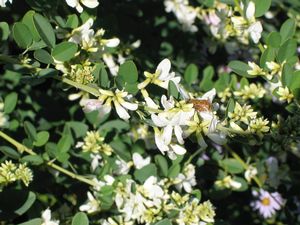Printed at http://www.quackingrassnursery.com/index.cfm/
Lespedeza thunbergii 'Avalanche'
Bush Clover
Plant Type:
DECIDUOUS SHRUBSLespedeza thunbergii ‘Avalanche’ – 'Avalanche' is a later blooming selection with white pea flowers on an unusually upright shrub on stronger stems, bucking the weeping tendency of its siblings... so why the name 'Avalanche'? Go figure. Regardless of the somewhat inappropriate moniker it is a lovely selection of Lespedeza thunbergii f. albiflora. In USDA zone 5b ‘Avalanche’ blooms late enough that sometimes a hard frost will interrupt its flowering season; we hate that when it happens! Spring planting is advised in the northern part of its range. 'Avalanche' blooms late in the bush clover season.
Characteristics and Attributes for Lespedeza thunbergii 'Avalanche'
Season of Interest (Flowering)
- Late Summer / Autumn
Season of Interest (Foliage)
- Spring / Summer / into Autumn
Nature Attraction
- Honey Bees & Native Bees
Light
- Full Sun
- Mostly Sunny
Attributes
- Natural Garden
- Border
- Drought Tolerant
- Shrub Border
- Specimen
- Hedge
- Wildlife Garden
- Hedgerow
Growth Rate in the Garden
- Moderately Fast
Soil
- Draining
- Fertile
- Average
Origins
- Garden Origin
Propagated By
- Cutting Grown
Genus Overview: Lespedeza
Common Name: Shrub Bush Clover
We have great affection for the Bush Clovers. A soft looking shrub cloaked in clean blue green trifoliate leaves on stems that gracefully arch; vase-shaped earlier in the season the tendency for the semi-woody stems is to gently weep as the season progresses. They bloom on new wood during late season with amazing displays of pea flowers. We treat Bush Clover as an herbaceous perennial in the north, cutting it down to 2” stubs at the end of winter before new growth emerges. They are fantastic with Miscanthus, perennial sunflowers, Joe-pye weeds, butterfly bushes, ironweeds, asters and just plain beguiling with late blooming daylilies – oh, heck: they look great with anything and everything that blooms in the late season garden. Site them in full to nearly full sun planted in fertile draining soil where they will gradually increase their girth with each new annual flush of growth. All of the following offerings are cutting grown.



